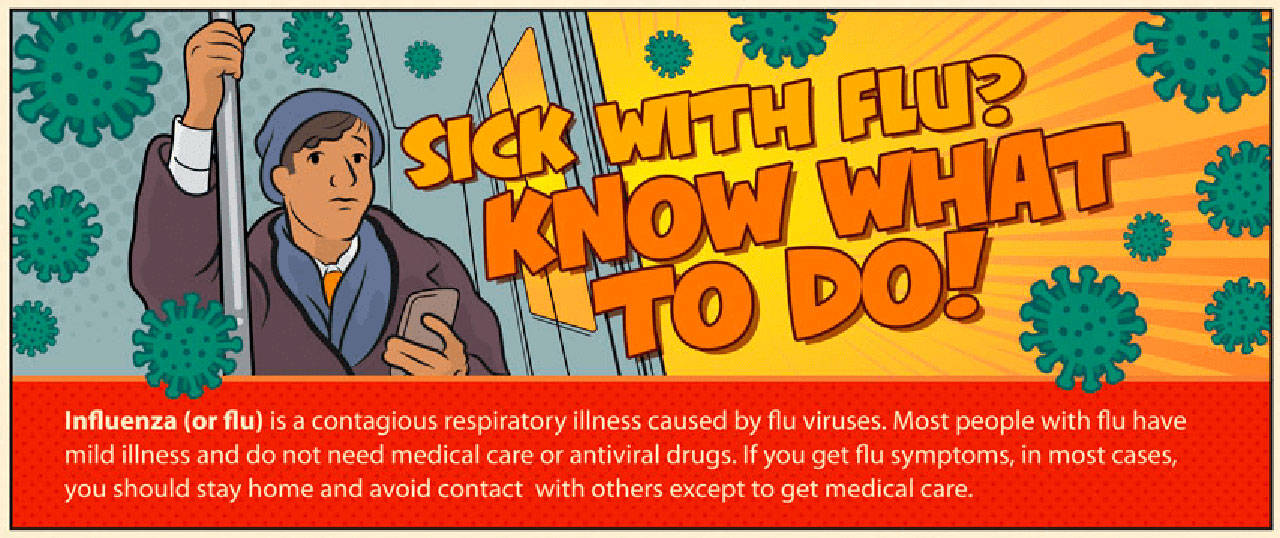The following was written by Meredith Li-Vollmer for Public Health Insider:
Even though the plum trees are blossoming and the heavy coats are disappearing, flu season is in full swing. And this year, hospitals are reporting a big uptick in the number of flu cases so far in March. We talked with Dr. Jeff Duchin, Health Officer for Public Health – Seattle & King County, to find out why there has been a marked increase in flu this late in the season and when to seek care if you have the flu.
Hospitals are reporting high numbers of patients with flu in the past few weeks. What explains why there are so many cases at this point in the season?
Jeff Duchin: During most flu seasons, there are four types of influenza viruses that circulate: two type A viruses and two type B. Often, we see influenza type A circulate early followed by an influenza type B later in the season. Flu is unpredictable – we can never predict when a flu season will start or end, or how severe it will be in advance. Compared with past seasons, this season is unusual because it began with circulation of influenza type A/H1N1, and now we are seeing a large, late surge in influenza A/H3N2, with both strains continuing to circulate. The A/H3N2 strain causes higher rates of severe illness, hospitalizations and deaths than the other types. Current levels of influenza-like illness and reports of lab-confirmed influenza are the highest that we’ve seen in recent years.
If flu is still circulating, is it still a good time to get a flu shot?
Absolutely. This season is a good example of why we recommend getting vaccinated throughout the flu season, as long as influenza is circulating. Flu vaccine is safe and effective. In fact, this year’s vaccine is about 47% effective, which means that if you get the flu vaccine your chances of getting the flu decreases by almost half. And if you do get sick and you’ve been vaccinated, it significantly reduces the length and severity of illness, preventing hospitalizations and death.
Who is at higher risk for serious illness and hospitalization from the flu?
Higher risk groups include:
- People age 65 and older
- Children younger than 5, but especially younger than 2 years old
- Pregnant women (and women up to two weeks postpartum)
- Residents of nursing homes and other long term care facilities
- American Indians and Alaskan Natives
- People with chronic medical conditions, including:
- diabetes
- asthma
- heart disease
- extreme obesity
- weakened immune systems
- neurological and neurodevelopmental conditions
- chronic lung disease
- blood, kidney, liver, or metabolic disorders
If you are in one of these higher risk groups and you develop flu symptoms, contact or see your healthcare provider right away. Antiviral medications taken within a day or two after the flu symptoms start can help people at higher risk avoid complications, including pneumonia, hospitalization, and death.
What if you have flu symptoms and you’re not in one of the higher risk groups?
If you have no underlying chronic health conditions and are not among the high-risk groups, you can usually treat yourself or your child at home by getting plenty of rest and drinking lots of fluids.
When should you see a doctor about the flu?
See a healthcare provider for an evaluation for any of the following:
- Fever greater than 100.4 degrees that’s lasted more than four days (fevers may be intermittent)
- Flu symptoms that improve but then return with fever and worse cough
- Coughing up mucus tinged with blood
- Rattling chest sounds when taking a deep breath
- Fainting spells, dizziness and/or severe dry mouth
- Urinating less (or babies have less than three wet diapers per 24 hours)
- Pregnant women should seek immediate care if they have flu symptoms rather than making an appointment at an OB office
- People younger than age five or older than age 65 who have flu symptoms
- People with flu symptoms who have chronic medical illness such as diabetes, heart failure, cancer, etc. or are in other high-risk groups for complications from the flu
Are there any times when someone should call 911 or go to an emergency room for flu?
Seek emergency medical attention if you are experiencing any of the following:
- Fast breathing or trouble breathing
- Pain or pressure in the chest or abdomen
- Bluish or gray skin color
- Severe or persistent vomiting
- Confusion, not waking up or not interacting
- Sudden dizziness
- Unable to talk in full sentences.
- Children with flu symptoms who are so irritable that they do not want to be held
Do you think this is a more severe flu season?
We won’t know for sure until the end of the flu season, which I expect to continue for another four to six weeks, possibly longer. If we look at the strains of flu that are circulating, it’s a mixed picture. The influenza A/H3N2 strain is more severe than the other strains, resulting in more hospitalizations and deaths than H1N1 and influenza B strains that are also circulating (but have been infrequently seen this season). However, until recently, the H1N1 virus predominated, so thus far, the impact has not been as bad on long term care facilities whose residents are among the most vulnerable to flu. At this time, the numbers of deaths are approximately half and outbreaks in long term care facilities are approximately a third of what they were last year, but those numbers are likely to increase if H3N2 continues to circulate.


